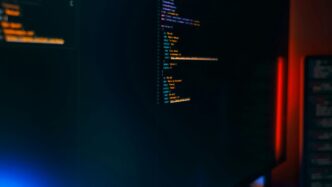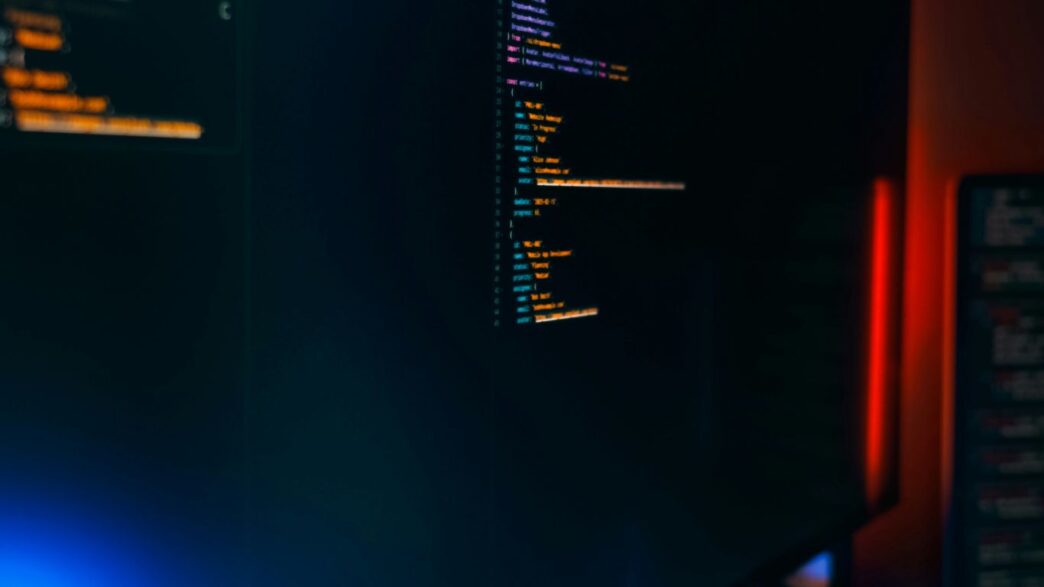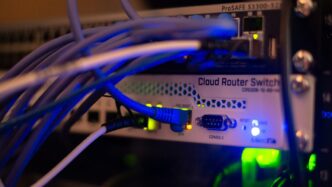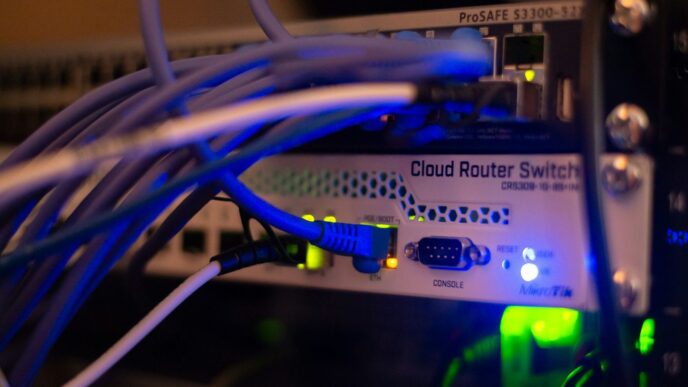It feels like every week there’s a new headline about a cyberattack, and honestly, it’s getting a bit much. The way these hackers network and operate is changing so fast, it’s hard to keep up. They’re getting smarter, using new tools, and finding ways around our defenses that we didn’t even think of. This article is going to break down what’s happening with the hackers network and what we can do to stay safer in 2025. It’s not just about big companies anymore; this affects everyone.
Key Takeaways
- Hackers are using AI to make their attacks way more powerful and harder to spot. They can automate tasks and find weaknesses faster than ever before.
- They’re getting sneaky, using normal computer tools and processes to hide their tracks and stay on systems longer without being noticed.
- Attacks are coming from everywhere, including targeting common devices like routers and messing with software we get from other companies (supply chain attacks).
- New tricks like deepfakes and fake identities are popping up, and they’re also getting better at using cryptocurrency platforms for their gains.
- Fighting back means working together, sharing information between governments and companies, and making sure everyone knows the risks.
The Evolving Landscape Of The Hackers Network

It feels like every week there’s a new headline about cyber threats, and honestly, it’s getting harder to keep up. The way hackers operate is changing so fast, it’s like trying to hit a moving target. They’re not just the lone wolves we used to hear about; it’s a whole ecosystem now, and it’s getting more complex.
AI’s Amplification Of Cyber Threats
Artificial intelligence isn’t just for making our lives easier anymore. It’s also a massive boost for cybercriminals. Think about it: AI can help them find weaknesses in systems way faster than a human could. They’re using it to automate attacks, create more convincing fake emails (phishing), and even generate fake identities for fraud. We’re seeing reports that state-sponsored groups are already using AI to discover and exploit vulnerabilities, and it’s only going to get more common. It’s a bit scary to think about how quickly this technology can be turned to malicious purposes.
Sophisticated Tradecraft To Evade Detection
As security gets better, hackers have to get smarter about hiding. They’re getting really good at blending in. One big trick is called "living off the land." This means they use the legitimate tools and programs already on a victim’s computer or network to do their dirty work. It makes it super hard for security software to tell the difference between normal activity and something malicious. They’re also getting quicker at getting in and out before anyone notices. The time attackers spend lurking on a system before they’re caught, known as dwell time, is actually dropping. This means they’re more stealthy and efficient than ever.
Geopolitical Motivations Behind Attacks
It’s not just about money anymore. A lot of what we’re seeing is tied to global politics. When countries are in conflict or have diplomatic spats, hacktivist groups often jump in. They might attack websites related to a conflict or a country they disagree with. Sometimes these groups are genuinely motivated by a cause, but other times they might just be looking for attention or to cause chaos. It makes the whole situation pretty unpredictable, and it’s hard to tell who’s really behind it all or if they’re working with a government.
Here’s a quick look at how some of these trends are playing out:
- AI-Powered Attacks: Automating vulnerability discovery and phishing campaigns.
- Stealthy Operations: "Living off the land" techniques to avoid detection.
- Geopolitical Influence: Hacktivism tied to international conflicts and tensions.
It’s a complex picture, and staying ahead means understanding all these different angles.
Exploiting The Digital Perimeter

Targeting Edge Devices For Network Entry
Hackers are getting really good at finding weak spots right at the edge of our networks. Think of these as the front doors and windows of your digital house. We’re talking about devices like routers, firewalls, and VPN gateways – the stuff that connects your internal systems to the outside world. When these devices have vulnerabilities, even newly discovered ones, attackers can sneak in. It’s like finding an unlocked back door. Once they’re in, they can watch everything that goes in and out, mess with the data, or even use that entry point to get deeper into your network. It’s a big problem because often, our security systems aren’t as good at watching these edge devices as they are at monitoring other parts of the network. This means attackers can stay hidden for a while, which is never a good thing.
The Growing Threat Of Supply Chain Attacks
This is a really sneaky one. Instead of attacking you directly, hackers go after one of your suppliers or partners. It’s like poisoning the well upstream. If a company you rely on for software, hardware, or even services gets compromised, the attackers can use that access to get to you. They might inject malicious code into a software update, or plant a backdoor in a piece of hardware before it even reaches your organization. This makes it incredibly hard to defend against because you’re trusting a third party, and you might not even know they’ve been compromised until it’s too late. It really highlights how interconnected everything is these days.
Leveraging Publicly Known Vulnerabilities
Sometimes, hackers don’t need to be super clever. They just need to be quick. There are always new security flaws being found in software and hardware. When these flaws are announced, there’s a race against time. Security teams need to patch these holes immediately. But if they’re too slow, attackers can use the publicly available information about the vulnerability to exploit it before any fixes are put in place. It’s like knowing a specific lock is broken and using that knowledge to break in before the owner can fix it. This is especially true for older systems that might not get updated as often, or for devices that are hard to manage, like those at the network edge.
Advanced Tactics Within The Hackers Network
Hackers aren’t just randomly poking around; they’re getting really good at hiding in plain sight. It’s like they’ve learned all the security guard’s routines and know exactly when to slip past unnoticed. They’re not using the same old noisy tools anymore. Instead, they’re "living off the land," which basically means they’re using the computer’s own built-in programs and legitimate software to do their dirty work. Think of it as using a company’s own tools to break into the office.
Living Off The Land For Stealth
This is where things get sneaky. Instead of bringing in their own hacking software, which security systems are designed to spot, attackers are grabbing tools that are already on the system. Things like PowerShell, PsExec, or even Windows Management Instrumentation (WMI) are fair game. They use these legitimate tools to move around the network, gather information, and even install malware. It makes it super hard to tell what’s a normal system process and what’s an attacker’s activity. They’re basically blending in with the crowd.
Abuse Of Legitimate Tools For Malicious Ends
It’s not just about using built-in tools; it’s about twisting them. Attackers might use a tool meant for system administrators to escalate their own privileges, giving them more control. Or they might use a software update utility to push out malicious code. They’re really good at finding ways to make these everyday tools do things they were never intended to do. It’s a clever way to bypass security measures that are looking for known malicious software.
Customizing Evasion Strategies
What’s really concerning is how adaptable these groups are. They don’t just use a one-size-fits-all approach. When they get into a network, they spend time figuring out exactly what security software is in place. Then, they tweak their tools and methods to specifically get around those defenses. They might rename files, change how their malware communicates, or alter registry settings to disable security features. This tailored approach makes them incredibly difficult to detect and stop. It’s like they’re building a custom key for every single lock they encounter.
Emerging Threats In The Hackers Network
Alright, let’s talk about what’s new and scary in the hacker world for 2025. It feels like every time we get a handle on one thing, a whole new set of problems pops up. It’s a bit like playing whack-a-mole, but with way higher stakes.
The Rise Of Deepfakes And Synthetic Identity Fraud
This is a big one. You’ve probably heard about deepfakes – those AI-generated videos or audio clips that look and sound real, but aren’t. Hackers are getting really good at making these. Imagine getting a video call from your boss asking for an urgent wire transfer, but it’s actually a deepfake. Or worse, they can create fake identities using bits of real people’s information combined with AI-generated faces and voices. This synthetic identity fraud makes it incredibly hard to tell who’s real and who’s not, opening doors for all sorts of scams and unauthorized access. It’s not just about fooling individuals; these fake identities can be used to open fraudulent accounts, apply for loans, or even infiltrate organizations.
AI-Driven Attacks And Automation
We’re seeing AI move beyond just creating fake content. Hackers are now using AI to automate their attacks. Think about it: AI can scan for vulnerabilities way faster than a human, figure out the best way to break into a system, and even adapt its attack methods on the fly if defenses change. This means attacks can happen quicker and on a much larger scale. It’s like giving hackers superpowers. They can test millions of passwords, find zero-day exploits, and launch coordinated attacks across many targets all at once, without needing a huge team.
Exploiting Cryptocurrency Platforms
Cryptocurrency is still a hot target. Because it’s decentralized and often has complex technical aspects, it can be a bit of a wild west. Hackers are constantly looking for ways to exploit vulnerabilities in exchanges, wallets, and decentralized finance (DeFi) protocols. This can involve everything from phishing attacks aimed at crypto holders to more sophisticated hacks that drain entire platforms. The anonymity that crypto offers can make it harder to track down the culprits, making it an attractive target for cybercriminals looking to make a quick profit.
Defending Against The Hackers Network In 2025
Okay, so the hackers are getting smarter, and their networks are getting more complex. It feels like every time we patch one hole, they find another. But that doesn’t mean we’re out of options. We’ve got to get serious about how we protect ourselves. The key is to stop thinking like we’re just reacting and start thinking proactively.
Implementing Network Traffic Analysis
This is about really watching what’s going on inside your network. It’s not just about seeing if someone is trying to break in from the outside; it’s about spotting weird behavior from the inside too. Think of it like a security guard who doesn’t just check IDs at the door but also keeps an eye on everyone once they’re inside.
- Look for the unusual: Are there sudden spikes in data leaving the network? Are systems talking to each other in ways they never have before? These are red flags.
- Baseline normal activity: You can’t spot the abnormal if you don’t know what normal looks like. Spend time understanding how your network usually behaves.
- Monitor edge devices closely: Remember those routers and VPNs we talked about? They’re prime targets. Make sure you’re watching traffic going through them extra carefully.
Automating Threat Detection And Response
Humans can only do so much, especially when attacks are happening at machine speed. We need tools that can spot threats automatically and, ideally, do something about them before they cause real damage. This isn’t about replacing people, but about giving them superpowers.
- AI-powered alerts: Systems that can learn what’s normal and flag deviations are a big help. They can sift through mountains of data way faster than any person.
- Automated blocking: When a threat is confirmed, can your system automatically isolate the infected machine or block the malicious IP address? This buys you time.
- Playbooks for common incidents: Have pre-defined steps for what to do when certain types of attacks happen. This reduces panic and speeds up recovery.
Strengthening Defenses With Tactical Intelligence
Knowing what the bad guys are up to before they hit you is a game-changer. This means staying informed about the latest tactics, tools, and targets. It’s like knowing the enemy’s battle plans.
- Stay updated on threat actor TTPs: What methods are hackers using right now? Are they focusing on phishing, exploiting specific software, or something else?
- Understand industry-specific risks: If you’re in healthcare, you know ransomware is a huge problem. If you’re in finance, you’re probably worried about account fraud. Tailor your defenses.
- Share information (carefully): Working with others in your industry or with security firms can provide insights you wouldn’t get on your own. It’s a shared fight.
The Critical Role Of Collaboration
Look, nobody’s got all the answers when it comes to cyber threats, right? It’s like trying to catch smoke. The hackers are always changing their game, and if we’re all just sitting in our own little silos, we’re going to get picked off one by one. That’s why working together is so important. We need to share what we know, and fast.
Industry And Government Partnerships
Think about it: companies have the inside scoop on what’s happening on the ground, what tools are being used, and what vulnerabilities they’re seeing. Governments, on the other hand, have resources for investigation and can often see the bigger picture, like coordinated attacks or state-sponsored activity. When these two groups team up, it’s a win-win. They can combine their intel to build better defenses and even go after the bad guys more effectively. It’s about creating a united front against a common enemy. This kind of partnership is key to staying ahead of the curve.
Enhancing Public Awareness Of Cybercrime
It’s not just about the big organizations, either. We all need to be more aware. So many attacks happen because people click on dodgy links or use weak passwords. Educating the public about common scams, like phishing emails or fake tech support calls, can make a huge difference. If everyone is a bit more savvy, it makes it much harder for hackers to find easy targets. Think of it like herd immunity, but for cyber threats. We can all play a part in making the internet a safer place.
Global Cyber Intelligence Sharing
Cybercrime doesn’t respect borders. A hacker in one country can wreak havoc on systems in another. That’s why international cooperation is a must. Sharing threat intelligence across countries allows us to spot patterns and track down criminal networks that operate globally. It means law enforcement agencies can work together, share evidence, and bring perpetrators to justice, no matter where they are. This kind of global cyber threat intelligence sharing is becoming more and more vital as attacks become more sophisticated and widespread.
Looking Ahead: Staying Ahead of the Curve
So, what’s the takeaway from all this? It’s pretty clear that the digital world isn’t getting any simpler when it comes to security. Hackers are getting smarter, using new tools like AI and finding clever ways to sneak past our defenses, often by targeting those edge devices we rely on. They’re also getting faster, meaning we have less time to react when something goes wrong. It’s not just about big companies either; everyone’s a target. The good news is, we’re not helpless. By staying informed about these evolving threats, patching our systems quickly, and using smart tools to watch for unusual activity, we can build stronger defenses. It really comes down to being prepared, working together, and not letting our guard down. The fight for cybersecurity is ongoing, and staying a step ahead is the best strategy we’ve got.
Frequently Asked Questions
What’s new with hackers in 2025?
Hackers are getting smarter and faster! They’re using cool new tools like AI to find weaknesses and launch attacks more effectively. They’re also getting better at hiding, making it harder to catch them. Think of them as constantly upgrading their spy gear to stay one step ahead.
How are hackers getting into computer systems?
Hackers are finding sneaky ways to get in. They might trick people into clicking bad links (like phishing emails), or they might go after devices that connect to networks, like your home router or office firewall. Sometimes, they even attack the companies that make the software you use, hoping to get in through that back door.
What does ‘living off the land’ mean for hackers?
It means hackers are using the tools already built into your computer or network to do their dirty work. Instead of bringing their own tools, they borrow legitimate programs to move around and cause trouble, which makes them much harder to spot because they look like normal activity.
Are there new types of scams I should watch out for?
Yes, definitely! Watch out for fake videos or audio (deepfakes) that can be used to trick people, and also for fake online identities created to steal information. Hackers are also using AI to make their attacks more convincing and automated.
How can we protect ourselves from these hackers?
It’s like building a strong fortress. We need to keep our software updated, use smart tools that watch for strange activity on our networks, and have quick ways to respond when something bad happens. Sharing information about new threats also helps everyone stay safer.
Why is working together important to stop hackers?
No one can fight hackers alone. When companies, governments, and even regular people share information and work together, we can build stronger defenses. It’s like a community watch program for the internet, making it harder for criminals to succeed.














